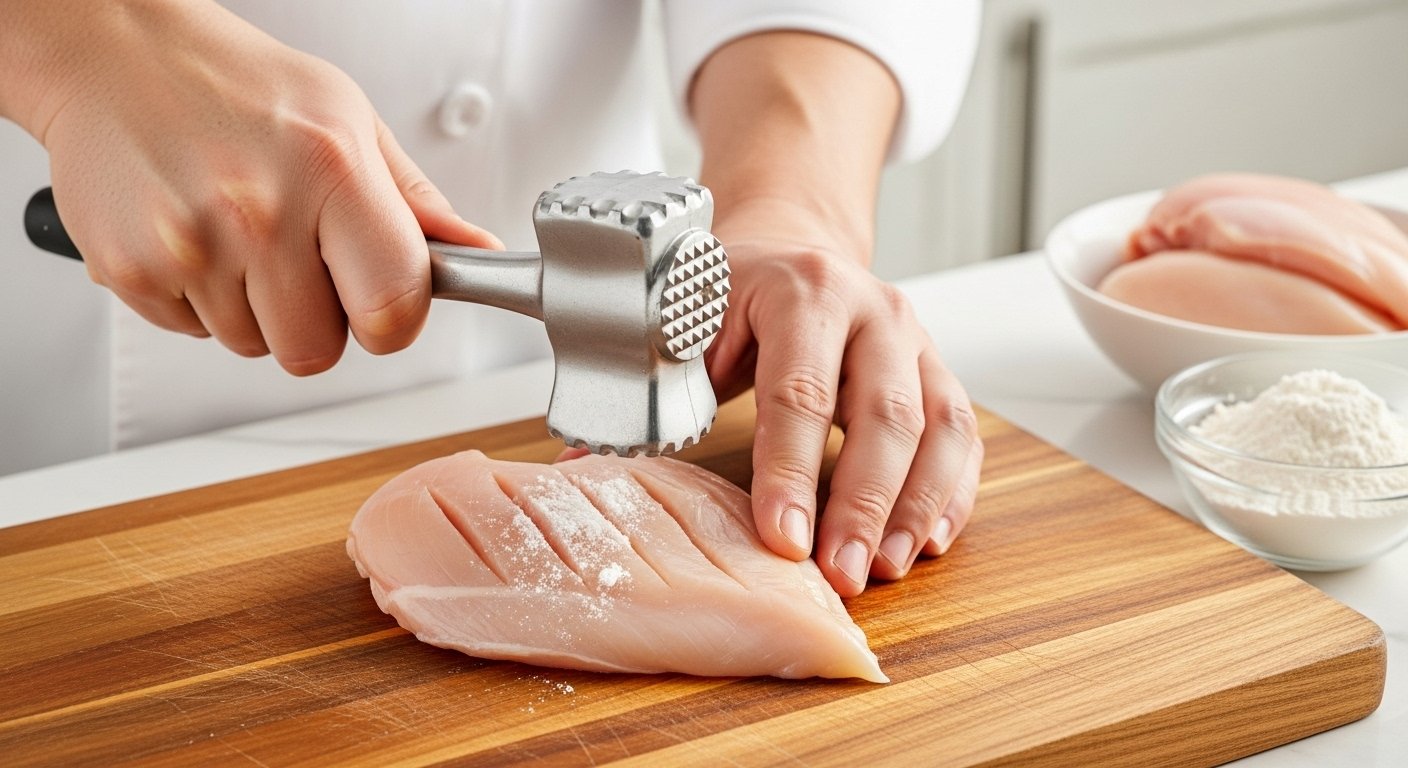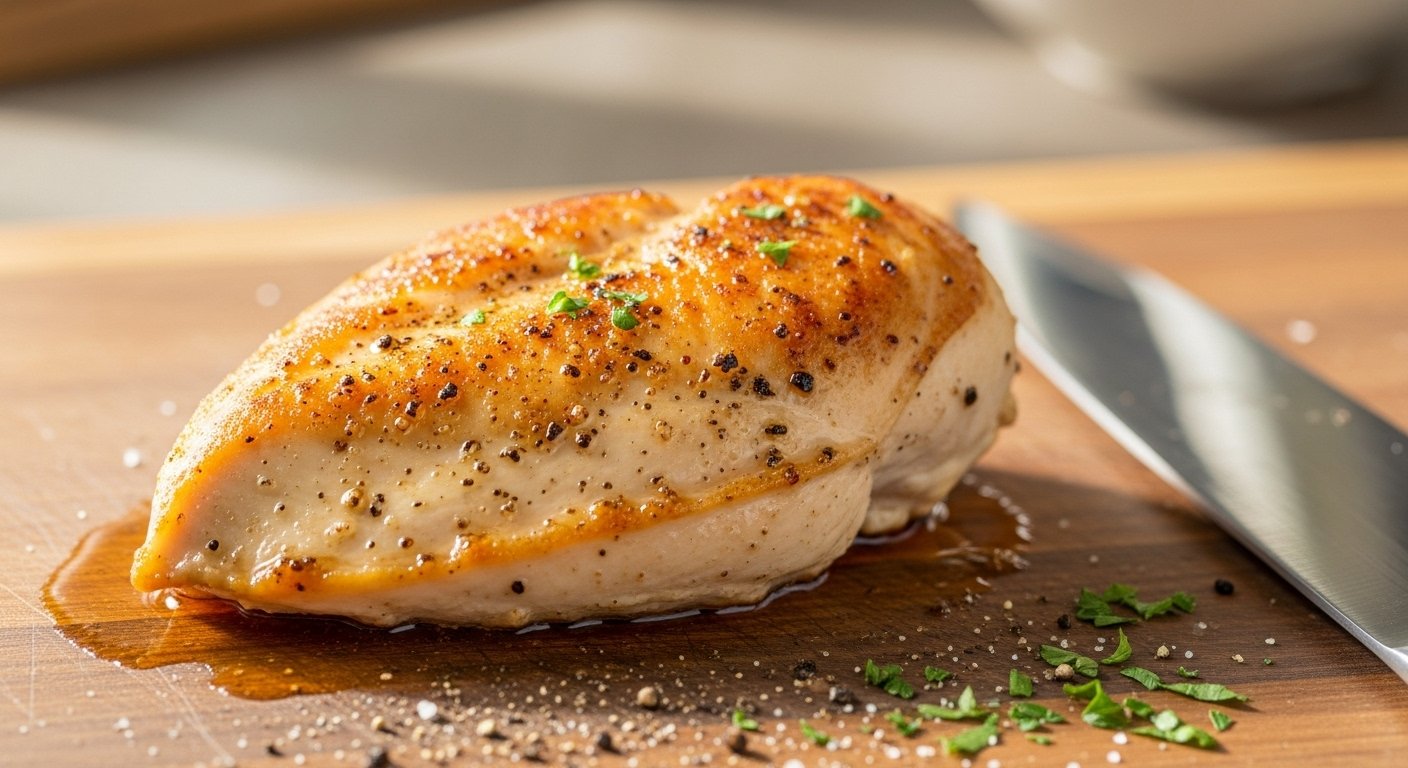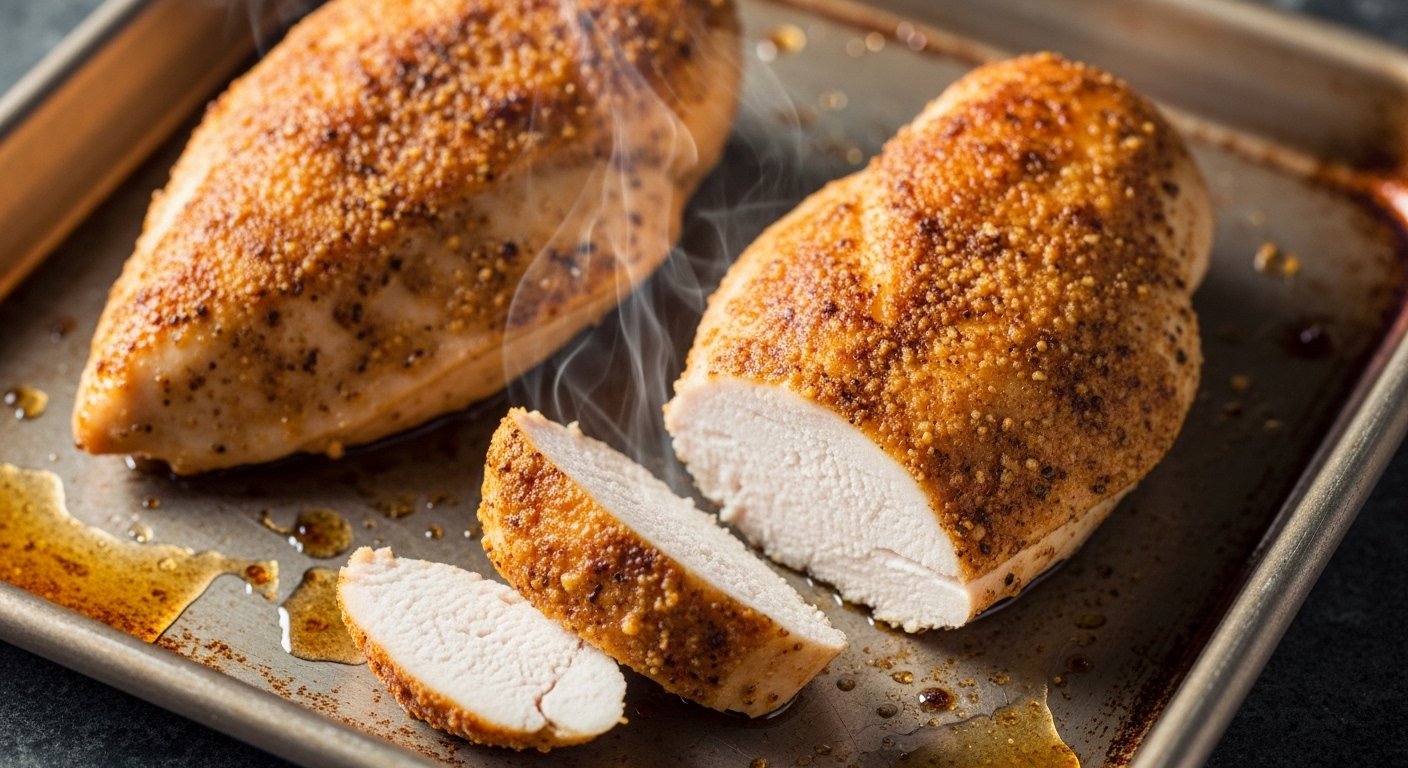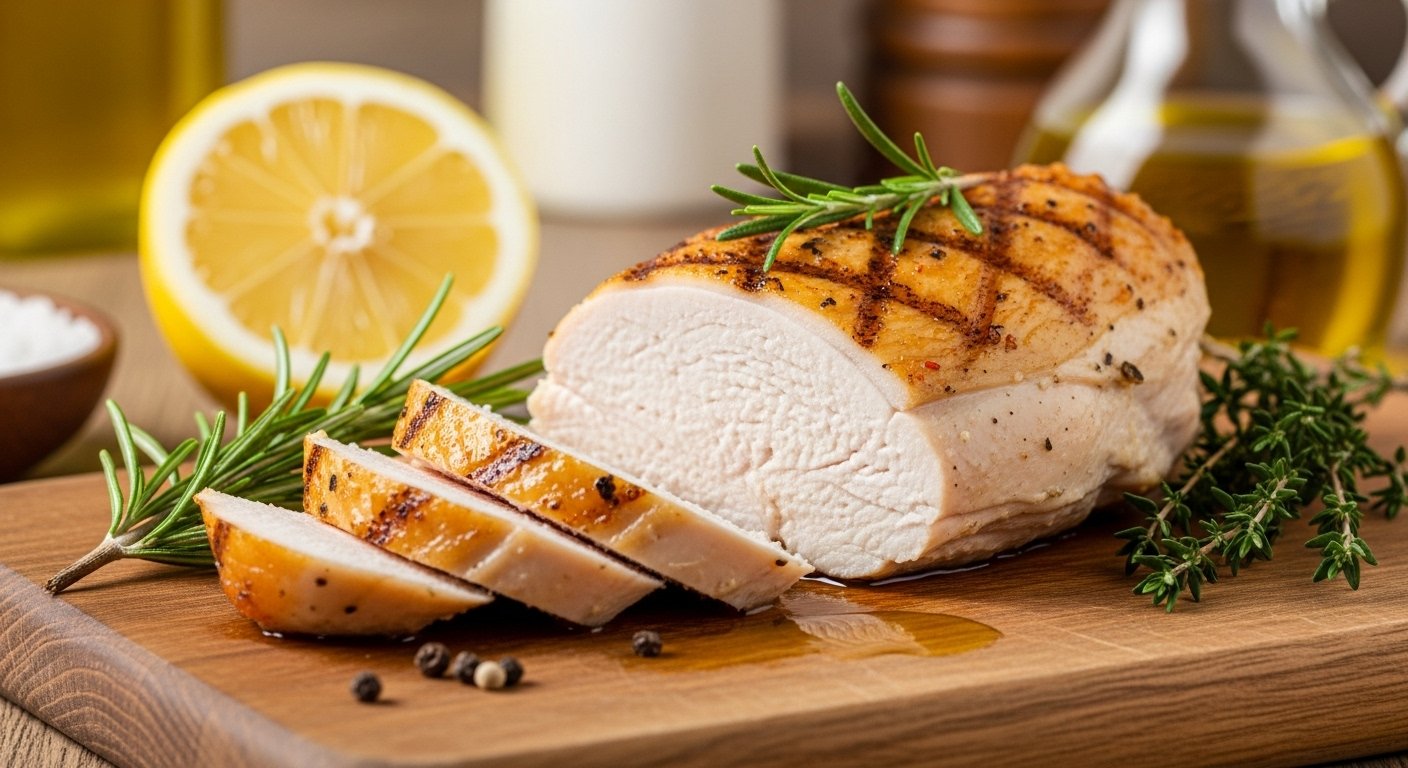Are you tired of dry, tough chicken breasts? You’re not alone! Many home cooks struggle with achieving that perfect, succulent texture. But what if we told you that consistently cooking juicy chicken breast is not only possible but also surprisingly simple? This comprehensive guide will equip you with the knowledge, techniques, and delicious recipes to transform your chicken breast cooking from hit-or-miss to perfectly tender, every single time. Get ready to impress yourself and your family with incredibly flavorful and moist chicken dishes!
How to Cook Juicy Chicken Breast: Quick Steps to Success
To ensure your chicken breast is always juicy and tender, follow these essential steps:
- Even Thickness: Pound chicken breasts to an even ½ to ¾-inch thickness to promote uniform cooking. [4]
- Marinate or Brine: Use a flavorful marinade or a simple brine to infuse moisture and flavor.
- Proper Seasoning: Season generously before cooking.
- Optimal Temperature Control: Cook to an internal temperature of 165°F (74°C) using a meat thermometer, as recommended by the USDA. [5, 12]
- Resting Period: Always allow the cooked chicken to rest for 5-10 minutes before slicing to redistribute juices.

Why is Chicken Breast So Popular (and Often So Dry)?
Chicken breast is a lean, versatile, and affordable protein, making it a staple in countless kitchens. Its mild flavor pairs well with a huge variety of cuisines, and it’s a go-to for healthy eating and meal prepping. However, its low-fat content is also its biggest challenge. Without enough fat to provide moisture, chicken breast is highly susceptible to drying out if overcooked.
Overcooking is a widespread issue, with many home cooks frequently resulting in dry and tough chicken breasts due to a fear of undercooking. The recommended safe internal temperature for chicken is 165°F (74°C); however, many consumers cook it to higher temperatures, leading to dryness. This fear is understandable, as undercooked chicken can pose health risks. However, relying on visual cues can be misleading. Approximately 49.6% of households judge chicken doneness by the inside color of the meat, and 39.2% by its texture, neither of which are reliable indicators for sufficient pathogen inactivation. [19] In fact, only using a food thermometer can accurately determine that chicken has reached a safe minimum internal temperature of 165°F throughout. [5] Alarmingly, among those who own a food thermometer, nearly half do not typically use it when cooking chicken products at home.
The Core Secrets to Keeping Chicken Breast Moist
So, how to keep chicken moist while cooking and prevent dry chicken breast? It all comes down to a few critical techniques that ensure moisture retention and tender results.
Pounding for Evenness
One of the simplest yet most effective ways to prevent dry, unevenly cooked chicken is to pound it to a uniform thickness. Boneless, skinless chicken breasts often vary in thickness, with one end being much thicker than the other. If you cook it as is, the thinner parts will be overcooked and dry by the time the thicker parts are safely done. Pounding chicken breasts to an even thickness is a commonly recommended technique to prevent uneven cooking, where thicker parts cook slower and thinner parts can become overcooked and dry. To do this, place the chicken breast between two sheets of plastic wrap or in a resealable bag and gently pound with a meat mallet, rolling pin, or even a heavy pan until it’s about ½ to ¾-inch thick. This also helps tenderize the meat, contributing to a more tender chicken breast.
The Power of Marinades and Brines
A well-chosen marinade or a simple brine can dramatically improve your chicken’s juiciness and flavor. These liquid baths work wonders for chicken breast moisture retention:
- Marinades: A juicy chicken breast marinade typically contains an acid (like lemon juice or vinegar), oil, and seasonings. The acid helps to tenderize the meat by breaking down some of the protein fibers, while the oil and seasonings infuse flavor. Marinated chicken breast recipes are fantastic for adding depth. Aim for at least 30 minutes, or up to 2-4 hours for more intense flavor and tenderness. You can find inspiration for delicious meals and beginner guide: cook delicious meals from scratch on our site.
- Brines: A brine is a salt and water solution, often with added sugar and aromatics. The salt helps the chicken absorb moisture through osmosis, leading to a noticeably juicier result. A quick brine of 15-30 minutes can make a significant difference, especially if you’re concerned about overcooking.
Proper Seasoning
Generous seasoning is key to flavorful chicken. Don’t be shy with salt, pepper, and your favorite herbs and spices. Seasoning chicken not only adds taste but also helps create a delicious crust during cooking. For an extra layer of flavor and texture, consider a light dredge in seasoned flour before pan-frying.
Mastering the Cook: Internal Temperature is Key
This is perhaps the most crucial tip for how to cook juicy chicken breast: cook to temperature, not to time. The recommended safe internal temperature for all poultry, including boneless skinless chicken breast, is 165°F (74°C). [5, 12] Using an instant-read meat thermometer inserted into the thickest part of the breast is the only reliable way to ensure it’s safely cooked without drying it out. Pull the chicken off the heat when it reaches 160-162°F (71-72°C), as its temperature will continue to rise a few degrees while it rests (this is called carryover cooking).
Why are my chicken breasts coming out dry? Overcooking is the number one culprit! Many people cook chicken until it’s well past 165°F, leading to moisture loss and a tough, dry texture. Why is my chicken tough or rubbery? Again, overcooking is a primary reason. When chicken proteins are exposed to high heat for too long, they contract tightly, squeezing out moisture and becoming tough or rubbery. Not pounding the chicken to an even thickness can also contribute to rubbery spots, as thinner sections cook faster and become overcooked while thicker parts are still cooking. [19]
Rest, Don’t Rush!
Once your chicken reaches the target temperature, remove it from the heat and let it rest on a cutting board, lightly tented with foil, for 5-10 minutes. This resting period allows the juices, which have been pushed to the center during cooking, to redistribute throughout the meat, resulting in a much juicier and more tender chicken breast. Skipping this step is a common mistake that leads to dry chicken, as all the delicious juices will run out onto your cutting board when you slice it. This simple technique is vital for juicy chicken breast moisture retention.
Popular Methods for How to Cook Juicy Chicken Breast
Let’s explore some of the best ways to cook chicken breast, ensuring tender, delicious results every time.
Pan-Frying for a Perfect Sear
Pan-seared chicken breast is a quick and delicious method that creates a beautiful golden crust while keeping the inside moist. This skillet chicken breast method is perfect for weeknight dinners.
Pan-Fried Chicken Breast Recipe Steps:
1. Prepare: Pound boneless skinless chicken breast to an even thickness (about ½-inch). Pat dry with paper towels to ensure a perfect chicken breast sear. Season generously with salt, pepper, garlic powder, and paprika.
2. Heat Skillet: Heat 1-2 tablespoons of olive oil or butter in a heavy-bottomed skillet (cast iron or stainless steel works best) over medium-high heat until shimmering. A hot pan is crucial for searing.
3. Sear: Place chicken breasts in the hot skillet, ensuring not to overcrowd the pan. Cook for 3-5 minutes per side, undisturbed, until deeply golden brown. This develops a delicious crust.
4. Finish Cooking: Reduce heat to medium-low. If your chicken is thicker, you might need to cover the pan and cook for an additional 5-7 minutes, or until the internal temperature reaches 160-162°F (71-72°C). [2]
5. Rest: Remove from pan and let rest for 5-10 minutes before slicing. Serve immediately.

Oven-Baked for Hands-Off Tenderness
Baked chicken breast is incredibly easy and a great option for meal prep. Our baked chicken breast tips will help you achieve juicy results without much fuss. If you’re wondering “What is the secret to juicy baked chicken?” it’s often a combination of proper temperature, a good marinade, and not overcooking.
Baked Chicken Breast Recipe Steps:
1. Preheat & Prepare: Preheat your oven to 400°F (200°C). Pound chicken breasts to an even thickness (about ¾-inch). Season or marinate your chicken.
2. Bake: Place seasoned chicken breasts in a single layer on a lightly oiled baking sheet or in an oven-safe dish. Bake for 18-25 minutes, depending on thickness, or until a meat thermometer inserted into the thickest part reads 160-162°F (71-72°C). [2, 10]
3. Rest: Remove from oven and let rest for 5-10 minutes before serving. This method is excellent for easy chicken breast dishes and is a fantastic way to cook boneless skinless chicken breast cooking without drying it out.

Grilling for Smoky Flavor
Grilled chicken breast juicy and smoky, perfect for warm weather and outdoor cooking. Grilled chicken breast recipes are a summer favorite.
Grilled Chicken Breast Recipe Steps:
1. Prepare: Pound chicken breasts to an even thickness (about ½-inch). Marinate for at least 30 minutes (or up to 4 hours) for extra flavor and tenderness. Season well.
2. Preheat Grill: Preheat your grill to medium-high heat (around 400-450°F / 200-230°C). Clean and lightly oil the grates.
3. Grill: Place chicken on the hot grill. Grill for 4-7 minutes per side, depending on thickness, until nice grill marks appear and the internal temperature reaches 160-162°F (71-72°C). [2, 18]
4. Rest: Transfer to a clean plate or cutting board and let rest for 5-10 minutes before slicing. For more tips on achieving a perfect crust, check out our guide on what’s the secret to perfectly crispy fried chicken.

Other Easy Chicken Breast Dishes
Beyond pan-frying, baking, and grilling, chicken breast can be prepared in numerous ways to achieve tenderness:
- Poaching: Gently simmering chicken breast in liquid (water, broth, or wine) is a fantastic way to keep it incredibly moist. It’s excellent for shredding into salads or sandwiches.
- Air Frying: An air fryer can produce surprisingly tender chicken breasts with a crispy exterior in less time than traditional baking. Remember to use a meat thermometer!
Common Pitfalls: Why Your Chicken Might Be Dry, Rubbery, or Tough
Understanding why your chicken sometimes doesn’t turn out perfectly can help you avoid future mistakes.
- Overcooking is the #1 Enemy: As mentioned, cooking past 165°F (74°C) will inevitably lead to dry, tough, and rubbery chicken. Get that meat thermometer and use it! [5, 12]
- Not Resting the Meat: Slicing immediately after cooking allows all the precious juices to escape, leaving you with dry meat. Always rest for 5-10 minutes. [5]
- Uneven Thickness: If your chicken breast isn’t pounded to an even thickness, parts of it will cook faster than others, leading to dry, overcooked sections while other parts are just done. [4]
- Too High Heat for Too Long: While searing needs high heat, prolonged high heat will dry out the chicken before the inside is cooked. Adjust heat as needed and finish cooking at a lower temperature or with indirect heat.
- Skipping Marinade or Brine: While not strictly necessary for safety, a good marinade or brine acts as an insurance policy against dryness, especially for beginners.
How Much Boneless Chicken Breast Per Person?
When planning your meals, a good rule of thumb is to allow one boneless, skinless chicken breast per person, especially if it’s the main protein. This typically translates to about 6-8 ounces (170-227 grams) of raw chicken per serving. If you’re serving smaller appetites, or if the chicken is part of a larger dish with other proteins or substantial sides, you might reduce that to 4-5 ounces (113-142 grams) per person. For meal prepping, having individual portions prepared can be a great time-saver. Consider checking out our ultimate guide: meal prepping for beginners for more tips.
Conclusion
Cooking juicy chicken breast is an art that’s easily mastered with the right techniques and a little attention to detail. By pounding your chicken to an even thickness, embracing marinades and brines, always using a meat thermometer, and allowing for a crucial resting period, you can say goodbye to dry, tough chicken forever. Experiment with pan-frying, baking, and grilling to find your favorite methods, and confidently create delicious, tender chicken dishes that will become family favorites. Happy cooking!
